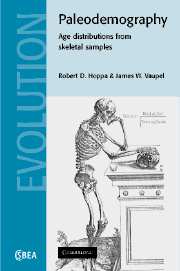Book contents
- Frontmatter
- Contents
- List of contributors
- Acknowledgments
- 1 The Rostock Manifesto for paleodemography: the way from stage to age
- 2 Paleodemography: looking back and thinking ahead
- 3 Reference samples: the first step in linking biology and age in the human skeleton
- 4 Aging through the ages: historical perspectives on age indicator methods
- 5 Transition analysis: a new method for estimating age from skeletons
- 6 Age estimation by tooth cementum annulation: perspectives of a new validation study
- 7 Mortality models for paleodemography
- 8 Linking age-at-death distributions and ancient population dynamics: a case study
- 9 A solution to the problem of obtaining a mortality schedule for paleodemographic data
- 10 Estimating age-at-death distributions from skeletal samples: a multivariate latent-trait approach
- 11 Markov chain Monte Carlo estimation of hazard model parameters in paleodemography
- 12 A re-examination of the age-at-death distribution of Indian Knoll
- Index
8 - Linking age-at-death distributions and ancient population dynamics: a case study
Published online by Cambridge University Press: 28 August 2009
- Frontmatter
- Contents
- List of contributors
- Acknowledgments
- 1 The Rostock Manifesto for paleodemography: the way from stage to age
- 2 Paleodemography: looking back and thinking ahead
- 3 Reference samples: the first step in linking biology and age in the human skeleton
- 4 Aging through the ages: historical perspectives on age indicator methods
- 5 Transition analysis: a new method for estimating age from skeletons
- 6 Age estimation by tooth cementum annulation: perspectives of a new validation study
- 7 Mortality models for paleodemography
- 8 Linking age-at-death distributions and ancient population dynamics: a case study
- 9 A solution to the problem of obtaining a mortality schedule for paleodemographic data
- 10 Estimating age-at-death distributions from skeletal samples: a multivariate latent-trait approach
- 11 Markov chain Monte Carlo estimation of hazard model parameters in paleodemography
- 12 A re-examination of the age-at-death distribution of Indian Knoll
- Index
Summary
Introduction
Skeletal series recovered by archaeologists frequently display patterns of death that differ from those of typical living, or historically documented, populations. Some of these prehistoric patterns are extremely widespread. Widespread patterns include notably small proportions of infants (see e.g., Acsádi and Nemeskéri 1970; Lovejoy et al. 1977; Buikstra et al. 1986), high proportions of older children and young adults (see e.g., Acsádi and Nemeskéri 1970; Weiss 1973; Lovejoy et al. 1977; Keckler 1997; Paine 1997), and an apparent excess of female death during the young adult years (Acsádi and Neméskeri 1970; Boldsen and Paine 1995, 1999). Most paleodemographers would agree that the small proportion of infants is primarily an issue of preservation and recovery (e.g., Buikstra et al. 1986). The other patterns have produced a wide range of explanations ranging from concerns about the archaeological process and paleodemographic methods (Bocquet-Appel and Masset 1982, 1996; Walker et al. 1988; Konigsberg and Frankenberg 1994; Konigsberg et al. 1997), to epidemiological ones (e.g., Lovejoy et al. 1977).
Relationships between demographic characteristics of a living population and a skeletal series recovered from it are not straightforward (Sattenspiel and Harpending 1983; Wood et al. 1992; Paine 1997). If we wish to understand the demography of the living population, we must develop explicit, testable models (see e.g., Keckler 1997; Paine 1997, 2000) that clearly define relationships between the two (Howell 1982; Wood et al. 1992).
Information
- Type
- Chapter
- Information
- PaleodemographyAge Distributions from Skeletal Samples, pp. 169 - 180Publisher: Cambridge University PressPrint publication year: 2002
Accessibility standard: Unknown
Why this information is here
This section outlines the accessibility features of this content - including support for screen readers, full keyboard navigation and high-contrast display options. This may not be relevant for you.Accessibility Information
- 22
- Cited by
